|
|
| 'Like' us on Facebook | Follow us: |
Posted on: Feb 17, 2015
Spiritual Symbolism in the Worship of the Supreme as Shiva
In a discourse delivered in May 1968, during the first world conference of the Sri Sathya Sai Organisation, Bhagawan declared, “This Human Form is one in which every Divine Entity, every Divine Principle, that is to say, all the Names and Forms ascribed by man to God, are manifest.” If He is the embodiment of every form of Divinity mankind has ever worshipped, what then is the significance of worshipping Him as Lord Shiva?
Pedda Bottu, was a devotee who was blessed with the unique opportunity of enjoying the proximity of ‘two Sais’ - of Shirdi and Parthi. When she ventured to write a book that would be a manual for those who wish to offer a ritualistic worship to Bhagawan, she had this beautiful experience. Bhagawan had guided her through dreams and visions as to what must go into the book. When finally it was completed, she placed the manuscript in the box she always kept it in, and did not go back to it for a while. But when after a few days she opened the book, she found to her pleasant surprise, that corrections had been made in several places in the unmistakable handwriting of Baba. And one remarkable correction she noted was - wherever she had referred to Baba as Sarva Devata Swarupa (the Embodiment of all forms of Divinity), it had been corrected to read, Sarva Devata Athitha Swarupa, indicating that this Avatar transcends the magnificence of all known forms of the Divine. He revealed that, He was the manifestation of every Divine Entity man had ever worshipped and much more!
 |
Why Give the Formless a Form?
If we look up to Bhagawan as that Supreme Being that is beyond the limiting descriptions of any deity or God, why then worship Him as the mighty Lord Shiva or for that matter Shiva Shakthi - the Unmanifest and the Manifest aspects of Divinity. One can never claim to know answers that address such secrets - the vedas describe the Truth as being beyond the reach of reason and words. But pondering over them can grant us insights that will take us closer to that incomprehensible Principle. A question often posed by the rational thinkers of times contemporary and foregone is, did God create man or man create God? For a rationalist it does seem an exercise in mere self-glorification to claim that God has a body similar to our own (of course with a few extra limbs and heads, may be to piously and humbly give Him the edge). When it comes to history of the Universe we still are blind men groping an elephant, but we know this much that the human form is quite a late entry into the scene, almost an afterthought! If one were to look at the Universe from the Big Bang right upto the present century, equating it to the scale of one year - that is if we say the Big Bang happened on 1 January and the present moment is the last second of 31 December, then the solar system came to exist sometime in September. The dinosaurs were still ruling the earth till 30 December and one of the precursors to the Homo sapiens, the Homo erectus made a last minute dash into the scene at 10:48 p.m. on 31 December; and Christ was born barely 5 seconds before the day ended. Given this scientific cum historic perspective, it does seem ostentatious to claim that God has a body similar to ours, sits in a meditative pose like us or even reacts the way we do when angered or pleased. So the question is, did God create man in His own image, or did man cast God in his image?
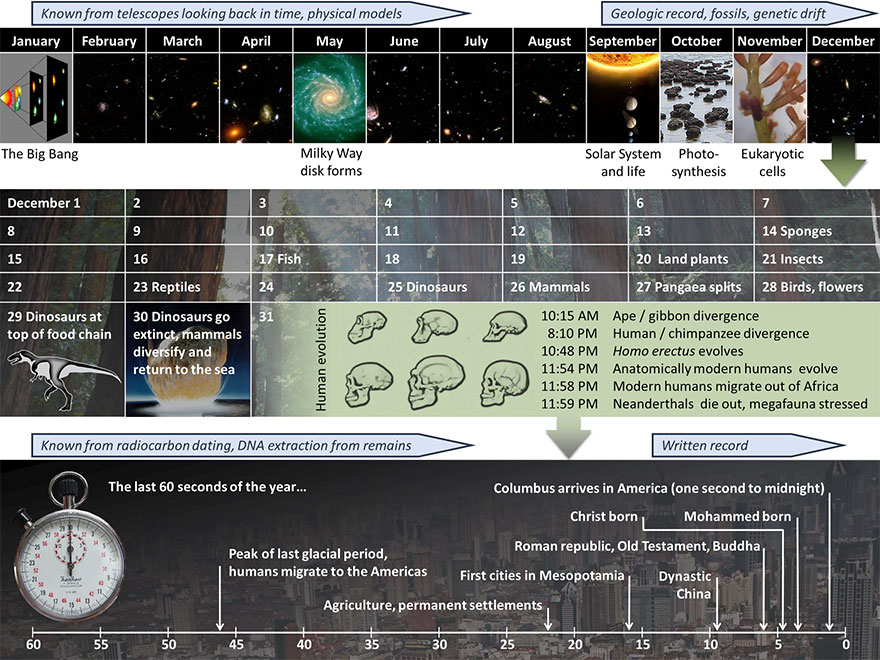 |
| The 13.8 billion year lifetime of the universe mapped onto a single year. At this scale the Big Bang takes place at the instant of midnight going into January 1, and the current time is the end of December 31 at midnight, and the longest human life is about 1/4th of a second, a blink of an eye.The scale was popularized by Carl Sagan in his book The Dragons of Eden and on the television series Cosmos, which he hosted. Source |
Always, our learning has been a process of gradual expansion of our understanding. We are introduced to a concept that is within the bounds of our conception, and gradually the concept is expanded, making it more complex, more robust and eventually much more comprehensive compared to what we started with. This is how we started learning mathematics - the initial lessons of addition could be explained with our fingers or imaginary apples in our bags and geometry was the study of simple squares and circles; but within a span of 10-12 years we are comfortably living with concepts like numbers that when squared give us negative integers, or the curious mobius strip from topology. It is a process of gradually expanding one’s understanding. And often an obstinate attempt to understand things as real as they are through the limitations we possess could lead to nothing more than confusion.
A student walks into a biology lab where there are numerous samples laid out. Bottled samples of the human lung, the gut of a goat, the brain of a monkey and so on. He then walks up to a glass slide which is labelled, ‘Human Cheek Cells.’ He peers at it intently from every angle, but it looks empty. He walks up to his teacher and complains that one sample on display is missing. The teacher walks up with the student to the sample, looks at the slide lying right where she had placed it and says, “But it is right there.” “But I can’t see it madam”, protests the student. Then the teacher draws his attention to a placard that says, ‘This Sample is Invisible to the Naked Eye.’ What is the point in insisting to see with one’s naked eyes, that which by its nature is invisible to the naked eye? Similarly what by definition is beyond the comprehension of the Human mind, can it be understood with the human mind? But what can be done, and what all spiritual masters do is present the Truth in a manner such that it can be grasped by or related to by our minds. Then the concept is gradually expanded to its true glory, which in the process breaks the shackles of the reasoning mind giving one the universal perspective. Einstein once said, “A mind that has been stretched will never return to it's original dimension.” It is so true and it holds good for the spiritual expansion of the mind too. That is why it is said, Jnana is that which once comes, will never leave - one can never return to the state of ignorance after having seen through the eyes of Jnana.
 |
Symbolism in Spirituality
This precisely must be the reason why symbolism has always been a trusted lieutenant of all cultures. The wise ones have seen and experienced something that is life changing. But that principle, to be imparted is personified or wrapped in symbolism. And may be instead of rejecting the symbolisms and personifications as inane, if we were to ponder on why the Supreme was constricted into these forms, it may well be to our benefit. We do this in every field - in science, in art, in technology; but when it comes to God, it makes some of us uncomfortable.
For instance, when we do a chemical reaction in the lab, we write down a chemical equation, denoting each reactant by a chemical formula. Common salt becomes NaCl, Hydrochloric Acid becomes HCl, Sodium Hydroxide becomes NaOH. This is no rocket science, if you are reading this article you will well know these formulae already. The point being made is this - Can you show any molecule in common salt that looks like an ‘N’, an ‘a’, a ‘C’ or an ‘l’. Is there anything in common salt that looks like any of these alphabets or all of them put together? Look at it with the best of magnifying devices, we still won’t find anything that even bears a distant resemblance. So aren’t the scientists and teachers cheating us by making us learn that salt is NaCl? Absolutely not! Though there is nothing in the compound that looks like any of the alphabets or numbers, we use these characters to denote them, and this exercise gives us a better understanding of the compound and it’s nature. But it goes without saying that no sensible student of science forgets the fact that these are merely representative.
Similarly though our scriptures emphasise repeatedly that the Divine Principle is formless, attributeless (Gunatita), beyond emotions (Bhavatita) and unitary (Ekam), it also gives us the forms of the many deities to worship, adore and try to please. This representation eggs us to explore the One who is beyond reason. It is akin to asking a salt doll to take a dip in the ocean saying, “Oh it’s nothing, the ocean is just as far as that horizon is. Just keep looking at it and swimming.” And the salt doll, becomes one with the ocean in that very process.
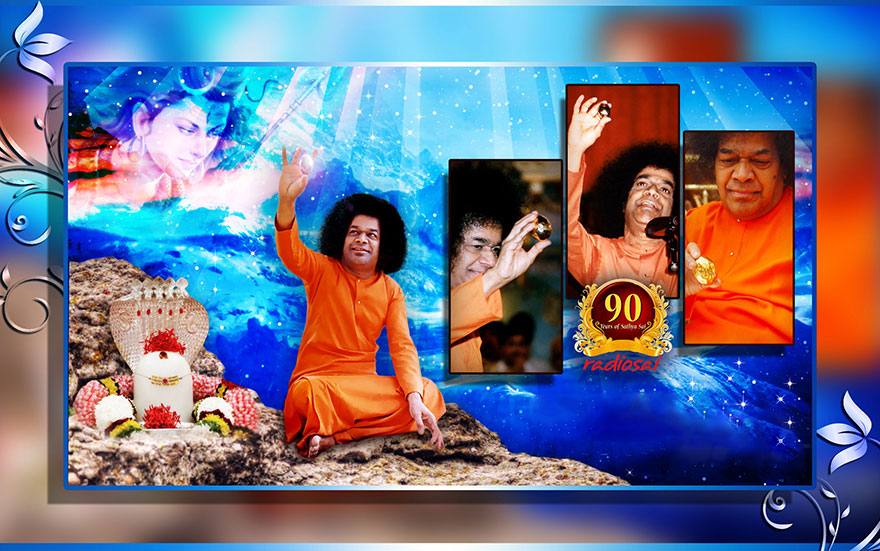 |
Comprehending Divinity Through Lord Shiva
Among the myriad forms that Sanatana Dharma offers to us, that of Lord Shiva is truly one of the most awe inspiring and profound. Beginning from His appearance to His nature, from His dance to His meditative posture, this indeed is a phenomenon worth lifetimes of contemplation. The most striking of them all being the ‘Dance of Creation’ or Tandava Nritya. He is referred to as the Lord of Dance - Nataraja. It is one thing to depict God as an artist and all of creation as His art, and there does seem to be some significance to that. Or as a sculptor or even a divine director. But one wonders why the art of dance? And the explanation given is, dance is a form of art in which the art and the artist can never be separated; a hint at the truth that the creator and the creation cannot be separated. And the life and vibrancy we see in the world is the pulsating dance of that Cosmic Dancer. Even in dance, Lord Nataraja is depicted as performing various forms of Tandava, the primary ones being Ananda Tandava (dance of joy) and the Rudra Tandava (Dance of destruction). One can imagine God Almighty in a joyous dance of benevolence, but why a dance of destruction?
The message is quite candid - see Him in pain as much as you see Him in Joy; see His grace in tribulations as much as you do in moments of elation. We often see life as a pursuit or journey in which we seek pleasures and manoeuvre around the potholes of pain, suffering and defeat. We acquire knowledge to equip ourselves for this journey. We accumulate wealth for the same reason, gather around us friends and family for the same. But what is needed is to step back and see the purpose and value of these opposites, and to lead life with a dignified and wise indifference, you could call it detachment or vairagya. And this acceptance comes when we can see the Lord as the dispenser of both pain and pleasure, He still being the Supreme Protector.
May be that is the reason why Lord Shiva is depicted the way He is - adorned with slithering serpents, which most people find repulsive, ashes of burnt corpses smeared all over and sitting in a graveyard as a perfect picture of dispassion. Why should He be pictured thus with objects and places that most of us find distasteful? Divinity is beyond the dualities of likes and dislikes. All belong to Him and He despises nothing and no one - that could be the message isn’t it?
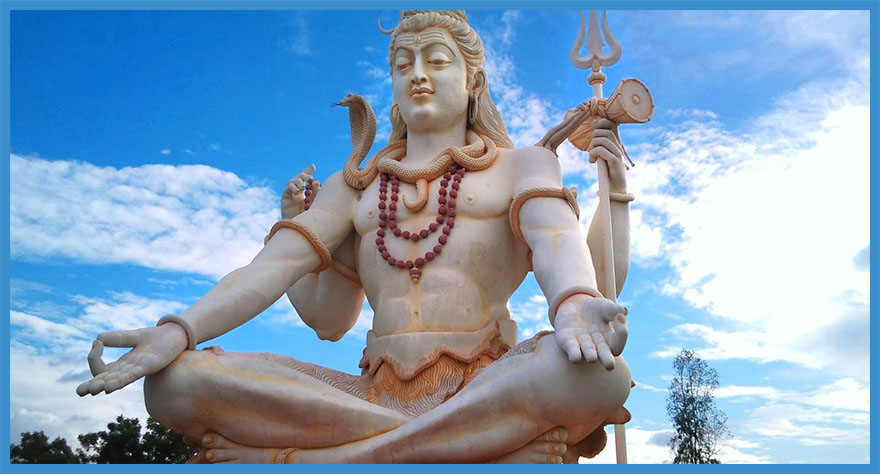 |
Lord Shiva is also referred to as Yogeshwara - the Master of all yogis. A yogi is one who has perfected the art of staying in union with the God within. In other words, a yogi is one who is self-contained and that perfection is expressed as dispassion (the antonym of yogi being bhogi, one who is ever running after pleasures and desires). And Lord Shiva is Yogeshwara - the very overlord of such dispassion. And how beautiful it is that when we praise the Mother we sing, “Jaya Yogeshwara Hrudaya Nivasini - He is the Supreme Lord of dispassion, but You have found a place in His heart, and we salute Thee”.
But how was this place in His heart won? Lord Shiva is extolled as Bholanath, meaning He is the Lord who is innocent. Many a tales on Lord Shiva explain how He is easy to please and confers on all what they seek, even those that come to Him with evil intentions can hope to win boons. A Lord who is the picture of renunciation is portrayed as the one who is ready to bestow riches and comfort if pleased! But as the story goes, Mother Parvati realises that you can get from the Lord what you want, but to get the Lord Himself, renunciation is the only means. It is to convey this message possibly that Mother Parvathi is portrayed as the daughter of the great emperor Himavan, who gives up riches, pleasures and family in pursuit of the hand of the Lord Himself.
But before we conclude about the nature of this union between Shiva and Parvati, let us not forget the episode of Kamadahana (the vanquishing of the Lord of Love). The episode goes that the Gods desperate for relief from a demon called Tarakasura realise that the nemesis to the problem lies with the son to be born to Lord Shiva and Mother Parvati. They send Kamadeva, the God of conjugal love to gently wake up Shiva from His meditation and induce Him to join the company of Mother Parvati. Kamadeva creates an unseasonal spring which has no effect on the Lord. He then audaciously fires the cupid’s arrow of flowers at Lord Shiva. Enraged by which the Lord unleashes the fire of fury from His third eye and incinerates Kamadeva instantly.
Lord Shiva represents the Divine Principle or the Supreme Godhead - Parameshwara. Mother Parvati represents nature or creation in general - Prakriti. One could conclude that this episode highlights the truth that the Lord has selfless love for His creation, but it is not tainted with the attachment seen in worldly love. That is the difference between Prema and Kama. The Sanskrit language clearly distinguishes the two.
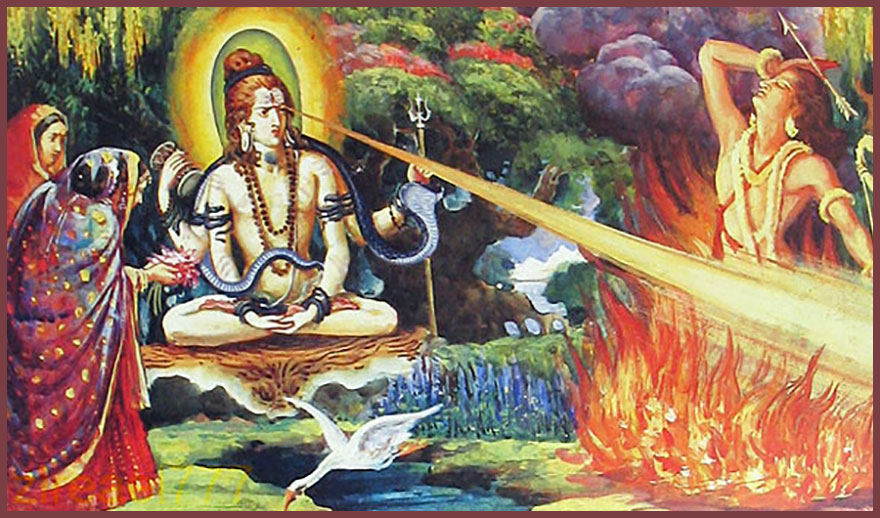 |
The list of such lessons that could be drawn is indeed endless, but for the sake of brevity let us contemplate on just one last powerful lesson. Most deities in the Sanatana Dharma have an animal for a vehicle, and the one for Shiva is the mighty bull, Nandi. Visit any Shiva temple in the world and you will find the devout bull placed outside the sanctum. But why outside? And there lies a beautiful message for all those devoted to the Lord. Though the Nandi is physically outside the shrine, notice his gaze - it is constantly and firmly fixed on his Lord. Isn’t that what Bhagawan exhorts us to do? Live in the world, but let your vision be ever fixed on the Divine ‘within’. And what would happen if one were to live that way?
There is another profound incident from the puranas. Shiva also has the appellation, ‘Tripurantaka’ a title that adorns Him in reminiscence of the destruction of the triple-city, Tripura which was ruled by three villainous brothers. The demonic brothers had won a boon that would protect their three cities from any mortal or divine weapon. The architect and devotee of Lord Shiva, Mayasura (spelt Mayaasuraa) constructed a marvellous triple-city (Tripura) which would be constantly in motion. The boon that they had was that this city could be destroyed only when all three are aligned to each other - an event which would occur for few moments in 1000 years; and can be destroyed by just one arrow. Having fortified their fabulous cities thus, gradually the Asuras, drunk with the spirit of invincibility, begin to trouble the innocent. All the Gods and the pious rush to Lord Shiva seeking His protection.
The lord vows to destroy Tripura exactly at that opportune moment. The God’s then fashion a formidable chariot for Shiva - the earth the chariot base, the Sun and the Moon as wheels and Lord Brahma Himself as the charioteer. The imposing mount Meru was to be the bow, snake Vasuki the bow-string and Vishnu became the arrow. Agni (God of fire) took position as the tip of the arrow and Vayu (Wind God) lodged himself in its feathers. As the moment, that rare moment for the destruction of the triple-city arrived, Shiva drew the string and was about to fire the fatal arrow. But it is said, that just then the Gods who had pitched in to form the Lord’s formidable armoury bloated with pride that it was because of their contribution that this task was to be accomplished. But at the last moment, Shiva does not fire the arrow, He merely smiles and the three cities go up in flames. And that very moment, the Gods realise their folly and vanity. Lord Shiva who is pleased by the devotion of the wicked, wouldn’t He be pleased with sincere repentance. So He fires the arrow and lets them participate in the divine task already accomplished. The lessons in this episode are quite obvious and stand out, don’t they?
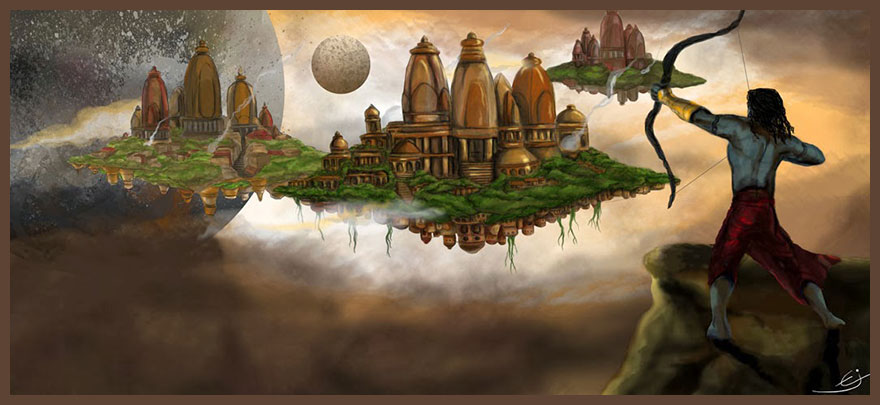 |
But we began with talking about Nandi. What was his role in this drama? It is said that Mayasura, the architect did not have the heart to see his best creation be destroyed before his very eyes. Nor did his devout heart permit him to pray to his Lord to not do what He had chosen to. So he decides that at the moment when Shiva fires His arrow he would lodge himself deep in the city and get destroyed along with his best creation. When Lord Shiva draws His mighty bow to shoot the arrow, he hesitates for a moment, and the others wonder if the Lord’s compassion will let the critical moment pass. None of them know the reason for this reluctance, but the Lord’s dear devotee, whose vision is ever fixed on his Master, Nandi, senses Lord Shiva’s unspoken desire. And even as the arrow is released, Nandi bursts into a sprint towards the to-be-doomed triple-city; he overtakes the arrow, enters the city and heads straight to the place where the Lord’s devotee, Mayasura is sitting in prayer waiting for his last moments. He picks him up just before the Lords arrow could decimate Tripura completely and runs out to safety, thereby fulfilling his Lord’s desire to save His pious devotee. A good devotee follows the commands of the Lord, but the best amongst them would follow the Lord’s wish even if it is unspoken.
“I am Siva-Sakthi”
It is quite difficult to say if these myriad forms of Divinity were used as means to express the profound by the great masters of the yore, or if that Absolute One chose to reveal Himself through these many forms. Whatever it may be, it is undoubtedly a means that will make us lead ideal lives and help us reach the ultimate goal of life. Isn’t that why Bhagawan encouraged the celebration of festivals like the Shivaratri? In fact He revealed Himself as Lord Shiva on multiple occasions to devotees drawn to that form.
Mr. Seshagiri Rao was a reluctant visitor to Puttaparthi. It was way back in 1943, a time when this little holy hamlet which is now a destination to passport holders of over a hundred and fifty countries, would not have found a place in most Indian maps. He came as a mere escort for his excited daughters, vowing not to even glance at the 'sixteen year old, non-brahmin, school dropout.' He told his daughters, “I am a worshipper of the great Lord, Shiva. I am not going to defile myself by indulging in such blasphemy.” But a glance was all it took – one look at the young Baba and he fell into a dead faint. He laid in that unconscious state for two whole days, nursed by Baba Himself.
And when he finally opened his eyes to the relief of his daughters he said to them, “You both can return now, but without me!” The man who would not step into Puttaparthi was saying he was not going to leave for ever! He was still in service when this happened; he had made up his mind to even quit his job from Puttaparthi. But what brought about this change. He shared his revealing experience thus: “When I walked into that compound, and I saw the young boy sitting on the rock, in His face, I had the vision of Lord Shiva. On His head, I saw the moon, and on His forehead, I saw the third eye! This is the Lord Shiva I have been worshipping for the past fifty years. And now that I have seen Him, why would I leave Him? I shall not.” He not only encouraged us to observe the worship of Lord Shiva, but even revealed that he was Himself Lord Shiva.
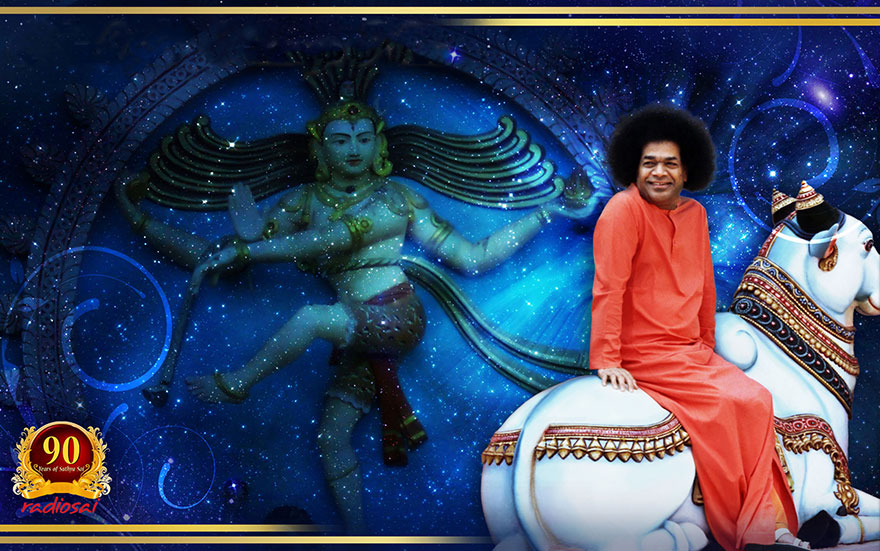 |
"I have been keeping back from you all these years one secret about Me; the time has come when I can reveal it to you, for this is a sacred day. I am Shiva-Sakthi." These were the words of Bhagawan on that glorious Guru Poornima day in 1963 when He had stunned all gathered by curing Himself of a stroke, and further left them flabbergasted by the above declaration. Why did He have to emphasise that He is Shiva or Shiva-Shakti when He is the Sarva Devata Athitha Swarupa? It can only mean that there is definite benefit for all of us in contemplating on the form and glory of Lord Shiva. The interpretations and explanations given above are not complete; no explanation can ever be complete! All these at best can be pointers to the Truth, and that truth has to be perceived through one’s own effort. Even as we participate in the Shivaratri celebrations, let us ruminate over the profound messages that is embedded and embalmed in these stories, images and symbolisms. It is sure to take us closer to our own true Self. For as Bhagawan would say, “When you chant, ‘Namaha Shivaya’ you are reminding yourself, ‘Not me, Shiva alone’, I do not exist as a separate entity, in reality I am myself Shiva - Shivoham Shivoham!!”
Thank you and loving Sai Ram,
Team Radio Sai
What are your impressions about the Article? Please let us know by writing in to h2h@radiosai.org or you may leave your thoughts in the comments section. Do not forget to mention your name and country.
| comments powered by Disqus |






